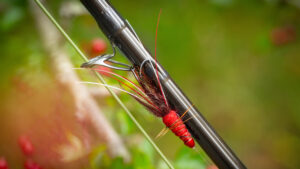SWITCHING CODES AND TARGETING BASS WITH YOUR SALMON GEAR CAN OFFER SOME FANTASTIC SPORT!
Switching codes and targeting bass can be a nice distraction from slow summer fishing on the river and may even provide much more than just a quick visit to the seaside to “try something new” when you realise what the coast can offer in terms of a fly-fishing experience. Bass offers some fantastic sport, but there are other species, too (mullet, pollack etc.), and the opportunities for saltwater fly fishing around the UK & Ireland are endless. There is no escaping from the fact that we are experiencing significant changes in our climate. As trends continue towards warmer summers, lower water levels and higher river temperatures, sometimes it is the best decision to leave the salmon alone. Instead of packing the rods away, think again! Not too far from most salmon rivers are estuaries and coastal areas that are home to bass. A fish that can be caught on the fly rods you might currently have rigged up for salmon.


Double-Handers On The Coast
An emerging trend in the UK and Irish coastal bass fishing scene is that of using double-handed rods. Anglers are beginning to realise the benefits of using these rods on the coast. This is nothing new; on the east coast of America, the striped bass fraternity has been using these rods for many years, and even on the coast here, some bass fly anglers have made the switch in recent times, with good success.
I enjoy using my single-hander on the coast; however, lately, I find myself reaching for my switch rod more and more. This is not because it is something new and exciting to try but mainly because of the benefits the DH offers the coastal fly fisher. Coming from the river and salmon angling roots, the double-handed rod feels familiar in hand, especially when swinging or drifting flies in current. However, really unlocking the potential of these rods comes from mastering the overhead cast. In essence, the DH rods allow the angler to deliver a longer cast with less effort increasing your fishing efficiency.


Fishing An Integrated Line
It is important to note that I prefer overhead casting with fully integrated lines, as the transition is generally smoother in the forward cast when overhead casting, with less hinging. This means you can strip fly to the rod tip, using an adjusted roll cast action; you can extend the short shooting head out past the rod tip, then with one overhead cast and a smooth forward cast, you can deliver a 20-30 yard cast with ease on coastal rock marks. That would usually take 2 or 3 false casts with the single-handed rod. Most salmon anglers know the importance of the bottom hand in the forward cast and are familiar with overhead casting (when needed). Bringing this knowledge to the coast can provide a real advantage by helping to efficiently deliver long overhead casts. YouTube offers excellent video content and tutorials on two-hand overhead casting, discussion, and demonstrations.
Fishing Skagit & Scandi Heads
Most salmon anglers are comfortable in current and familiar with swinging flies, and this will again give you a real advantage on the coast. Currents formed around estuaries, sand bars and rocky headlands can often be great places to search for bass. In this current or river-like scenario, I use my Scandi and Skagit head setups with interchangeable tips (300-400 grain). Drifting and swinging flatwing style patterns can also be a great technique but also try stripping flies (similar to sunrays); takes can be explosive. Estuary mouths are very similar in character to rivers, and a Spey-style step and swing approach can serve you well and allow you to cover ground and find that hot spot where the bass may be sitting and waiting during a flood or ebb tide when the tide is running. I like to switch between tips and fish the varying depths starting high and working my way down (like salmon fishing).


Areas To Target
If you aren’t familiar with coastal fishing and need some help to get started, you can find more information on locations and the when and where of coastal bass fishing on the links below:
Part 1 – https://www.guideflyfishingblog.co.uk/coastal-fly-fishing-for-bass/
Part 2 – https://www.guideflyfishingblog.co.uk/coastal-fly-fishing-for-bass-part-2/
The pursuit of bass with your favourite salmon setup add can add an extra dimension to your season, whether the water levels are low, fishing is slow or you simply want the challenge of something new, I’d strongly encourage you to hit the coast and swap chasing one type of silver for another.






